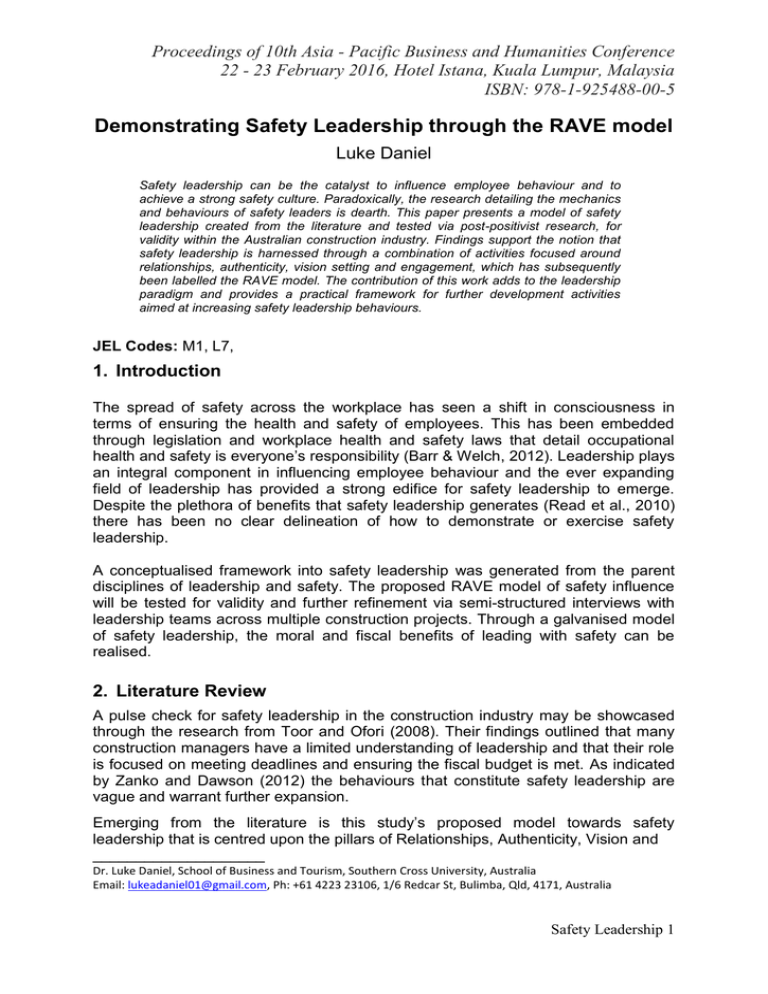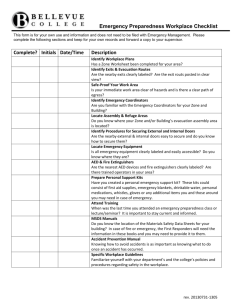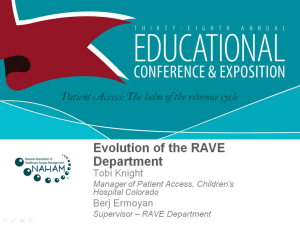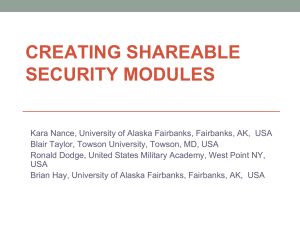Proceedings of 10th Asia - Pacific Business and Humanities Conference
advertisement

Proceedings of 10th Asia - Pacific Business and Humanities Conference 22 - 23 February 2016, Hotel Istana, Kuala Lumpur, Malaysia ISBN: 978-1-925488-00-5 Demonstrating Safety Leadership through the RAVE model Luke Daniel Safety leadership can be the catalyst to influence employee behaviour and to achieve a strong safety culture. Paradoxically, the research detailing the mechanics and behaviours of safety leaders is dearth. This paper presents a model of safety leadership created from the literature and tested via post-positivist research, for validity within the Australian construction industry. Findings support the notion that safety leadership is harnessed through a combination of activities focused around relationships, authenticity, vision setting and engagement, which has subsequently been labelled the RAVE model. The contribution of this work adds to the leadership paradigm and provides a practical framework for further development activities aimed at increasing safety leadership behaviours. JEL Codes: M1, L7, 1. Introduction The spread of safety across the workplace has seen a shift in consciousness in terms of ensuring the health and safety of employees. This has been embedded through legislation and workplace health and safety laws that detail occupational health and safety is everyone’s responsibility (Barr & Welch, 2012). Leadership plays an integral component in influencing employee behaviour and the ever expanding field of leadership has provided a strong edifice for safety leadership to emerge. Despite the plethora of benefits that safety leadership generates (Read et al., 2010) there has been no clear delineation of how to demonstrate or exercise safety leadership. A conceptualised framework into safety leadership was generated from the parent disciplines of leadership and safety. The proposed RAVE model of safety influence will be tested for validity and further refinement via semi-structured interviews with leadership teams across multiple construction projects. Through a galvanised model of safety leadership, the moral and fiscal benefits of leading with safety can be realised. 2. Literature Review A pulse check for safety leadership in the construction industry may be showcased through the research from Toor and Ofori (2008). Their findings outlined that many construction managers have a limited understanding of leadership and that their role is focused on meeting deadlines and ensuring the fiscal budget is met. As indicated by Zanko and Dawson (2012) the behaviours that constitute safety leadership are vague and warrant further expansion. Emerging from the literature is this study’s proposed model towards safety leadership that is centred upon the pillars of Relationships, Authenticity, Vision and ____________________ Dr. Luke Daniel, School of Business and Tourism, Southern Cross University, Australia Email: lukeadaniel01@gmail.com, Ph: +61 4223 23106, 1/6 Redcar St, Bulimba, Qld, 4171, Australia Safety Leadership 1 Proceedings of 10th Asia - Pacific Business and Humanities Conference 22 - 23 February 2016, Hotel Istana, Kuala Lumpur, Malaysia ISBN: 978-1-925488-00-5 Engagement (RAVE) that have been driven by the leadership paradigm. Common threads of the literature have been pooled together to empirically test this framework. All elements, have been underpinned through the domain of safety and each component of the RAVE model has sub points to achieve that outcome. Details of the RAVE model have been displayed in Figure 1. Figure 1: Proposed RAVE Safety Leadership Model (Source: Developed from Koh & Rowlinson, 2012; Vlachoutsicos, 2011; Ehrhart & Klein, 2001; Palamar, Le & Friedman, 2012; Toor & Ofori, 2008; Leary & Tangley, 2003; Shamir & Eilam, 2005; Long, 2013; Halverson, Murphy & Riggio, 2004; Davis & Gardner, 2012; Cunliffe & Eriksen, 2011; Lapierre, Naidoo & Bonaccio, 2012; Hale et al., 2010; Hsiung, 2012) Relationships: Similarity Leader-member exchange Assertiveness - Engagement: - Communication Openness Distribution of justice Safety Leadership Authenticity: - Personal awareness Transparency Personal accountability Vision: - Clear Vision Commitment Rhetoric 2.1 Relationships Relationships defined through the RAVE model incorporate the worker/manager relationship via sub elements that allow the safety relationship to thrive. Relationships can therefore be seen as the outcome of the behaviours exercised to achieve this end point. The sub elements of Relationships include leader/member Safety Leadership 2 Proceedings of 10th Asia - Pacific Business and Humanities Conference 22 - 23 February 2016, Hotel Istana, Kuala Lumpur, Malaysia ISBN: 978-1-925488-00-5 exchange, assertiveness, social identification and similarity. The importance of relationships within the RAVE model will be rooted within the leader/member exchange paradigm and the importance of tapping into the social capital of work groups (Koh & Rowlinson, 2012). This is coupled with the compliance requirements of management safety systems, which can be executed through assertiveness from the safety leader. The importance of persuasion through social identification and similarity can be highlighted through shared working goals and mandatory metrics through a relationship of mutuality (Vlachoutsicos, 2011). The research behind the importance of social identification and similarity was governed by the research covered under charismatic leadership (Ehrhart & Klein, 2001). 2.2 Authenticity The RAVE component of Authenticity has the building blocks of authentic and thirdgenerational leadership embedded through it. Authenticity as an element of this proposed model is defined as the personal attribute of the safety leader that is constituted by accountability, personal awareness and transparency, with these outcomes leading to enhanced trust. A focus on personal accountability towards safety is expected to reflect a strong internal locus of control (Palamar, Le & Friedman, 2012). This can therefore influence others towards taking ownership towards their safety from a systems and personal point of view (Joseph, Reddy & Sharma, 2013). The markers of an effective safety culture are expected to be demonstrated through the facets of transparency and trust (Toor & Ofori, 2008). To set this as the ‘way things are done around here’, it is devised that a safety leader is forthcoming with information and transparent in all of their actions within their environment. A by-product of this is to share a culture of learning which can be best demonstrated by recognising personal cognitive biases, strengths and weaknesses (Leary & Tangley, 2003). Through self-awareness, it is expected that safety leaders can maximise their influence and lead others towards the macro goal of working within a safe environment or a workplace free of injury. A review of the literature outlined that, sharing of one’s own shortcomings can be the vehicle of transparency, while modelling authenticity (Shamir & Eilam, 2005). 2.3 Vision The Vision component of the proposed RAVE model is established upon the premise of safety leaders having a safety vision that they convey clearly to employees. This is made up of the sub elements of having a clear vision, commitment and suitable rhetoric. The importance of a vision has been linked to achieving macro goals and aligning employees (Long, 2013). When an incident occurs within an organisation, this may be the kind of crisis that kick starts the frontier of charismatic leadership by the setting of a new goal or vision Safety Leadership 3 Proceedings of 10th Asia - Pacific Business and Humanities Conference 22 - 23 February 2016, Hotel Istana, Kuala Lumpur, Malaysia ISBN: 978-1-925488-00-5 for the future (Halverson, Murphy & Riggio, 2004). Specifically within a safety leadership paradigm, it may be the kind of language utilised or the rhetoric that captures the attention of workers (Davis & Gardner, 2012). Inspiring team members may be fostered through expressive language and commitment to the cause. A commitment to safety can be painted through a clear vision, which is often pivotal within transformational and third generational leadership (Long 2013). The pearls of safety leadership may be entrenched with the ability to captivate a desired future of wellbeing and health through engagement. 2.4 Engagement One of the core components of the RAVE model has been based upon Engagement. Under the proposed RAVE model, Engagement has been defined as the overall outcome or behaviour that is constituted by communication, openness and distribution of justice. Without meaningful engagement, it is expected that safety issues and concerns will wither away into oblivion whilst organisational trust would be jeopardised (Cunliffe & Eriksen, 2011). Engagement driven by open and honest communication may build capital trust between the safety leader and team member (Lapierre, Naidoo & Bonaccio, 2012). It is theorised that equality and consistency with safety management systems will lead into effective engagement and interaction between key stakeholders through an emphasis on feedback and learning systems (Hale et al., 2010). Through openness to new ideas, it is forecasted that the incorporation of feedback can strengthen a relationship and therefore improve a discourse into safety. In order for relationships to be built around safety, safety leaders will need to be present and accessible to their team members and colleagues. Without face-to-face presence, it is forecasted that relationships will not be as strong or solidified (Cunliffe & Eriksen, 2011). 3. Research Methodology A post-positivist design was deemed more suited for this research due to the exploratory nature of the research question as well as the ontology of this researcher. Given that leadership is the balance between influence and reach, a semi-structured interview design was created to explore the behaviours of safety leadership from an interpretivist paradigm. Through a process of appreciative enquiry, the tenets of safety leadership were explored. Purposive sampling was chosen based upon the job position and employee reach. A total of 20 interviews were conducted with the population sample being comprised of general managers (GM), project managers (PM), construction managers (CM) and health, safety and environment (HSE) managers. Data saturation occurred with the chosen quota of participants. Data was collected across multiple construction projects, spread out throughout Australia within a top-tier construction company. Safety Leadership 4 Proceedings of 10th Asia - Pacific Business and Humanities Conference 22 - 23 February 2016, Hotel Istana, Kuala Lumpur, Malaysia ISBN: 978-1-925488-00-5 The coding of data was undertaken through a dual process of code and retrieve techniques, pertaining to the emergence and interrogation of data. These techniques assisted with the managing of data and grouping of concepts into information laden categories (Gough & Scott, 2000). To foster a thick description of the data, computer assisted programs were jettisoned in favour of manual coding. Triangulation protocols were adhered to through a combination of self-reflection throughout the coding process as well as a peer-review of the raw findings. Triangulation activities were undertaken to cater for the pillars of qualitative research through transferability, dependably and credibility as detailed from the work of Guba and Lincoln (2008). Immersing ones-self with the data and capturing direct quotes aided dependability of the data whilst transferability was adhered to via a thick description of the results. Credibility was maintained via consistency between each interview and stringent emulation and adherence to the interview procedures 4. Results Results indicated that the elements of Relationships, Authenticity, Vision and Engagement were all well representative components of effective safety leadership. This was consistent across all participants that were interviewed. 4.1 Relationships A plethora of information was obtained from the participants, who outlined the “huge importance” of relationships, in terms of safety leadership. The importance of relationships was reflected in the ability to influence others where ideally a person “needs to know who the guys are ... know what their attributes are” as well as providing discipline and being assertive. One comment made by an HSE manager was “safety is the people business” and that if one had a “mentoring and coaching type of role”, this would be the epitome of an effective safety leader. The importance of being accessible through having an “open door policy” and applying discipline are closely aligned to the sub-elements of assertiveness, accessibility and openness. There was minimal data referring to the proposed importance of social identification and factors of similarity were often based upon the common element of “family”. Components of assertiveness that was included as part of the proposed RAVE model were more reflected through factors of discipline. This included personal, employee and organisational discipline. One CM made the comment that you need “fairness in your levels of discipline. You don’t want to be looked at as a pushover” and as one PM stated “you can go around running and joking, you might have the respect but when it comes down to discipline, communication, they’re not going to listen”. Comments were also made about personal discipline, such as abiding by the rules and safety procedures that may be on site. Safety Leadership 5 Proceedings of 10th Asia - Pacific Business and Humanities Conference 22 - 23 February 2016, Hotel Istana, Kuala Lumpur, Malaysia ISBN: 978-1-925488-00-5 4.2 Authenticity Components of authenticity were well referenced in terms of honesty, selfawareness, transparency, accountability and “being genuine”. Authenticity was one of the most prevalent elements of the RAVE model. Levels of personal insight can be evidenced by one GM stating that safety leadership is about “admitting your weaknesses: don’t bullshit your way through” and other unguarded comments by an HSE manager who said “in the early days I was probably guilty of not being aware of the work practices” and “telling them [workers] if you failed them”. There were also comments made by participants about specific areas that they may be weak in or would like to improve upon. This was in relation to learning more about safety management processes or being more visible “in the field”. Credibility was a vocal element of Authenticity, with participants across all job positions stating “it all comes back to credibility”, “credibility is extremely important ... extremely important for leadership” and “need to be credible, because everyone would think you’re a piece of shit and you’re not a good leader”. Credibility was in sync with trust with one PM saying “we try and build up a trust conscript … so every time there is an issue, a concern raised we would try and put on a fourteen-day time frame to have issues resolved” and that “trust is one of those weird things where people will either give it to you or not give it to you”. An amalgamation of trust and credibility was shown through the importance of transparency. 4.3 Vision All participants identified the importance of goals and overall safety expectations. Quite often the safety vision was as broad as “making sure nobody gets hurt” or “our target is continuous improvement”. In contrast the vision was also specific, such as a personal safety action plan or team charter. The tangible documentation of a vision was notably absent across multiple participants as shown through such comments as: “it’s interesting, I have never documented a safety vision” and one GM saying “I think we are a bit void on the safety strategy and vision at the moment” and that most visions are expressed through verbalised expectations. The misalignment with a safety vision was reported to make people “lose my temper” and it begins to create challenges for shared employee commitment. In the conceptualised RAVE model, a sub-element of vision was rhetoric which was present in the findings with individuals revealing that a vision can be shared via “the delivery of stories. I think people remember that. I certainly remember stories more than particular facts”. As well as expressive language, which was reflected in the comment, “it’s the words in which you use them or how you use them”. Specific words that were used to promote a safety-leadership vision included “relentless”, “discipline”, and “consistency”. The creation of “silly slogans” and other platitudes towards safety such as “zero harm” were not well received. 4.4 Engagement The most well-supported element of the RAVE model related to engagement and communication. This was predicated by conversing with employees, utilising “humour to break down barriers”, “talking about your experiences” and having Safety Leadership 6 Proceedings of 10th Asia - Pacific Business and Humanities Conference 22 - 23 February 2016, Hotel Istana, Kuala Lumpur, Malaysia ISBN: 978-1-925488-00-5 general conversations with people, which may not be work-related. One GM mentioned “if you don’t like talking to people, you don’t like interactions, you’re an introvert, you will never be seen as a great safety leader” and it is “hard to show safety leadership without strong communication skills”. Engagement was often referred to as a collaborative approach to solving challenges and being “open and honest with the guys” whilst reinforcing what is working well. The benefits of engagement were attributed to “ownership” and “increased understanding” by sharing the reasons ‘why’ a safety initiative was implemented. A precursor for engagement was “building rapport first” through self-disclosure and “making the workplace a happy place through jokes and laughter” whilst leading “by being fair”. 4.5 Safety Management The role of statistics within safety leadership was deemed a platform to exhibit safety leadership behaviours and was an element encompassed by safety management. This was indicative across all job positions and outlined by such comments as “statistics provide a way to measure people” and that “the good part of statistics is that you can address a particular issue”. The challenge with statistics which makes them “a love-hate relationship” was influenced by injury rates and how statistics become the focal point of activities which can be deemed ”negative” given that ”80% of what we see is negative”. 5. Analysis Each relevant concept of the RAVE model has been modified to reflect current findings from this study. 5.1 Relationships Findings from this study underscore the importance of building relationships in order to influence others through safety leadership. These findings build upon previous research that details the importance of leader/member exchange. This can be amplified through the importance of relationship building in order to generate trust and openness between leaders and employees (Kath, Marks & Ranney, 2010). Results from this study strengthen the importance of having a personal belief in safety and displaying empathy towards others when promoting safety. Compassion and empathy have been linked to emotional intelligence and improved practice within a nursing environment (Rankin, 2013). The similarities of health and wellbeing can cross over to the safety sphere due to the objective of preserving life. Empathy has been included as a sub-element of the RAVE model as it was consistently linked from the research findings as a pre-cursor to relationship building when demonstrating safety leadership. The initial sub-component of Assertiveness in the RAVE model was replaced with Discipline to reflect the language from participants. Such supporting comments include “in construction you are always going to need that amount of discipline and line of authority” and “the most disciplined sites tend to be the safest sites”. Discipline also acts as an outlet when applying personal and organisational discipline Safety Leadership 7 Proceedings of 10th Asia - Pacific Business and Humanities Conference 22 - 23 February 2016, Hotel Istana, Kuala Lumpur, Malaysia ISBN: 978-1-925488-00-5 when working with safety management systems. Discipline as it is expressed in the RAVE model is also a reflection of personal discipline to abide by safety requirements as well as applying discipline to employees for any voluntary disregard to safety rules. Personal accountability has been moved as a sub-element of discipline. 5.2 Authenticity The findings from this research dictated the importance of being “credible” and operating with “integrity”, which can be a moderator for employee behaviour. The inclusion of the sub-element Demonstrated Safe Behaviours was established by multiple comments coming from participants stating that safety leaders need to “walk the walk”. Demonstrating safety remains an integral component of safety leadership and is the differing factor with other schools of leadership. In a study investigating the impact of authentic leadership on followers’ ethical decision-making in the face of temptation, it was shown that authentic leadership is a mediator when temptation is present (Cianci et al., 2014). These results can be transposed to the safety realm, where the temptation for employees could be taking a safety shortcut. The grounding of one’s own moral compass was evident in the exploration of safety leadership behaviours. As one person explained; “safety is intertwined with personal values and I think it’s intertwined with ethics whereas maybe organisational leadership is less so”. Such comments highlight levels of personal awareness and ethical conduct, which have been included as part of the RAVE model. The role of personal accountability in safety leadership was often quoted and paired with factors of transparency. The sub-element of Transparency differs from Openness, which has been listed under the Relationship element of the RAVE model. This is founded upon the context of transparency pertaining to the reporting of safety statistics and the sharing of safety incidents. The honest sharing of information has been shown to promote trust and increase vocal engagement with employees (Hsiung, 2012). 5.3 Vision A clear pathway of the desired state and what a project is aiming to achieve through its safety performance was found to be an occurring theme in this research. This was often verbalised by setting broader safety goals and outlining expectations. As a result of these findings, the RAVE sub-element of Commitment has been replaced with Expectations. If a safety leader is being transparent and authentic, then their commitment towards a broader vision would be validated through demonstrated safe behaviours. Safety expectations can be inclusive of safety goals or personal expectations. The constant striving for continuous learning that emerged as a secondary theme can be driven through the sub-element of a Clear Vision dictated by safety goals and expectations. Establishing a clear vision may be precipitated through the importance of language and rhetoric. The flare of the charismatic leader and the associated Safety Leadership 8 Proceedings of 10th Asia - Pacific Business and Humanities Conference 22 - 23 February 2016, Hotel Istana, Kuala Lumpur, Malaysia ISBN: 978-1-925488-00-5 characteristics of expressiveness and rhetoric were shown to be pivotal in times of crisis, which could be transposed to safety crises (Davis & Gardner, 2012). 5.4 Engagement Engagement provides an avenue for open dialogue as opposed to monologue, which can then be exercised through team-building, work training and leadership walkthroughs (Frankel, Leonard & Denham, 2006). Results from this research stressed the importance that engagement has in exercising open conversations, interactions and candid dialogue. The epitome of engagement was Communication. The ability to communicate safety information and provide a personal connectedness to the enduser is a skill that is needed to negotiate organisational barriers. The importance of communication within safety leadership was indicated by “one-on-one conversations”, and “talking to the guys”. If these conversations are peppered with honest and truthful safety information then the employee impact can guide mutual trust. The Distribution of Justice was part of the initial conceptualised RAVE model and was evident in issues relating to organisational fairness. Participants stated the importance of people being treated fairly alongside consistent discipline. These findings link in well with current research in procedural justice and the importance of setting up a culture of care (Read et al. 2010). The RAVE sub-component of Openness have been touted as key components towards building trust and organisational citizenship behaviour (Toor & Ofori, 2008). 5.5 Integrated RAVE Model Changes have been made to the RAVE model to accurately reflect the findings into safety leadership. The RAVE model can serve as a platform for the development of safety leaders across the construction industry. The aspect of Safety Management has been included in the RAVE model to reflect findings from this research and the output of Behaviours was included based upon information shared from participants. Figure 2 details the modified RAVE model. Safety Leadership 9 Proceedings of 10th Asia - Pacific Business and Humanities Conference 22 - 23 February 2016, Hotel Istana, Kuala Lumpur, Malaysia ISBN: 978-1-925488-00-5 Figure 2: Modified Conceptualised RAVE model Safety Management Systems: Relationships: - Leader-member exchange Empathy Discipline Similarity Lag/lead indicators Legislation Risk Assessments Reporting Processes - Engagement: - Communication Openness Distribution of Justice Authenticity: - Safety Leadership - Demonstrated Safe Behaviours Personal & Ethical awareness Transparency Behaviours: - Discussing safety - Leadership walk-throughs - Receiving and providing feedback - Outline expectations - Sharing safety stories and Vision: - Clear Vision Expectations Rhetoric values - Abiding by safety rules The benefits and behaviours detailed from these research findings can also be an indicator on the return on investment through the implementation of associated safety leadership initiatives, processes or programs. Safety Leadership 10 Proceedings of 10th Asia - Pacific Business and Humanities Conference 22 - 23 February 2016, Hotel Istana, Kuala Lumpur, Malaysia ISBN: 978-1-925488-00-5 6. Conclusion Through the incorporation of the RAVE model, safety leadership can be brought into the next frontier of evidenced-based practice. The pedigree placed upon working relationships exercised by engagement, headed by a common vision and fostered through authenticity can be the soup of activity that generates a strong safety culture. The RAVE model can be the building blocks of safety leadership with further developments and environmental changes enabling the model to remain contemporary and relevant. Application of the RAVE model can extend beyond the construction industry due to the core components and elements not being construction driven. This enhances the applicability of safety leadership across multiple industries with further application and confirmatory research supporting or negating this notion. References Barr, J & Welch A 2012, ‘Keeping nurse researchers safe: workplace health and safety issues’, Journal of Advanced Nursing, vol. 68, no. 7, pp. 1538–45. Cianci, AM, Hannah, ST, Roberts, RP & Tsakumis, GT 2014, ‘The effects of authentic leadership on followers’ ethical decision-making in the face of temptation: An experimental study’, The Leadership Quarterly, vol. 25, no. 4, pp. 581–94. Cunliffe, AL & Eriksen, M 2011, ‘Relational leadership’, Human Relations, vol. 64, no. 11, pp. 1425–49. Davis, KM & Gardner, WL 2012, ‘Charisma under crisis revisited: Presidential leadership, perceived leader effectiveness, and contextual influences’, The Leadership Quarterly, vol. 23, no. 5, pp. 918–33. Ehrhart, MG & Klein, KJ 2001, ‘Predicting followers’ preferences for charismatic leadership: The influence of follower values and personality’, The Leadership Quarterly, vol. 12, no. 2, pp. 153–79. Frankel, AS, Leonard, MW & Denham, CR 2006, ‘Fair and just culture, team behaviour and leadership engagement: The tools to achieve high reliability’, HSR: Health Services Research, vol. 41, no. 4, pp. 1690–1709. Gough, S & Scott, W 2000, ‘Exploring the purposes of qualitative data coding in educational enquiry: Insights from recent research’, Educational Studies, vol. 26, no. 3, pp. 339–54. Guba, EG & Lincoln, YS 2008, ‘Paradigmatic controversies, contradictions and emerging confluences’ in NK Denzin & YS Lincoln (eds.), The Landscape of Qualitative Research, Sage Publications, Thousand Oaks, pp. 255–86. Hale, AR, Guldenmund, FW, van Loenhout, PLCH & Oh, JIH 2010, ‘Evaluating safety management and culture interventions to improve safety: Effective intervention strategies’, Safety Science, Vol. 48, no. 8, pp. 1026-35. Safety Leadership 11 Proceedings of 10th Asia - Pacific Business and Humanities Conference 22 - 23 February 2016, Hotel Istana, Kuala Lumpur, Malaysia ISBN: 978-1-925488-00-5 Halverson, SK, Murphy, SE, & Riggio, RE 2004, ‘Charismatic leadership in crisis situations: A laboratory investigation of stress and crisis’, Small Group Research, vol. 35, no. 5, pp. 495–514. Hsiung, HH 2012, ‘Authentic leadership and employee voice behavior: A multi-level psychological process’, Journal of Business Ethics, vol. 107, no. 3, pp. 349–61. Kath, LM, Marks, KM & Ranney, J 2010, ‘Safety climate dimensions, leader–member exchange, and organisational support as predictors of upward safety communication in a sample of rail industry workers’, Safety Science, vol. 48, no. 5, pp. 643–50. Koh, TY & Rowlinson, S 2012, ‘Relational approach in managing construction project safety: A social capital perspective’, Accident Analysis Prevention, vol. 48, no. 1, pp. 134–44. Leary, MR, & Tangley, JP 2003, Handbook of Self and Identity, The Guildford Press, New York. Lapierre, LM, Naidoo, LJ & Bonaccio, S 2012, ‘Leaders’ relational self-concept and followers’ task performance: Implications for mentoring provided to followers’, The Leadership Quarterly, vol. 23, no. 5, pp. 766–74. Long, DG 2013, Delivering High Performance: The Third Generation Organisation, Gower Publishing Limited, Farnham. O’Dea, A & Flin, R 2001, ‘Site managers and safety leadership in the offshore oil and gas industry, Safety Science, vol. 37, no. 1, pp. 39–57. Palamar, M, Le, DT & Friedman, O 2012. ‘Acquiring ownership and the attribution of responsibility’, Cognition, vol. 124, no. 2, pp. 201–8. Rankin, B 2013, ‘Emotional intelligence: Enhancing values-based practice and compassionate care in nursing’, Journal of Advanced Nursing, vol. 69, no. 12, pp. 2717–25. Read, BR, Zartl-Klik, A, Veir, C, Samhaber, R & Zepic, H 2010, ‘Safety Leadership that engages the workforce to create sustainable HSE performance’, SPE International Conference on Health, Safety and Environment in Oil and Gas Exploration and Production, Rio de Janeiro, Brazil, pp. 1–18. Shamir, B & Eilam, G 2005, ‘What’s your story? A life-stories approach to authentic leadership development’, The Leadership Quarterly, vol. 16, no. 3, pp. 395– 417. Toor, SR & Ofori, G 2008, ‘Leadership for future construction industry: Agenda for authentic leadership’, International Journal of Project Management, vol. 26, no. 6, pp. 620–30. Vlachoutsicos, CA 2011, ‘How to cultivate engaged employees’, Harvard Business Review, vol. 89, no. 9, pp. 123–26. Zanko, M & Dawson, P 2012, ‘Occupational health and safety management in organisations: A review’, International Journal of Management Reviews, vol. 14, no. 3, pp. 328–44. Safety Leadership 12




